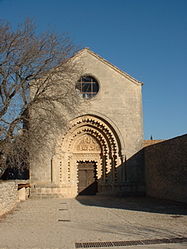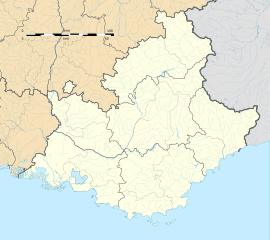Ganagobie
You can help expand this article with text translated from the corresponding article in French. (December 2008) Click [show] for important translation instructions.
|
Ganagobie | |
|---|---|
 The 12th century church of Our Lady, in Ganagobie | |
| Coordinates: 44°00′34″N 5°55′00″E / 44.0094°N 5.9167°E | |
| Country | France |
| Region | Provence-Alpes-Côte d'Azur |
| Department | Alpes-de-Haute-Provence |
| Arrondissement | Digne-les-Bains |
| Canton | Château-Arnoux-Saint-Auban |
| Intercommunality | Provence-Alpes Agglomération |
| Government | |
| • Mayor (2020–2026) | Sylvie Belmonte[1] |
| Area 1 | 10.5 km2 (4.1 sq mi) |
| Population (2021)[2] | 91 |
| • Density | 8.7/km2 (22/sq mi) |
| Time zone | UTC+01:00 (CET) |
| • Summer (DST) | UTC+02:00 (CEST) |
| INSEE/Postal code | 04091 /04310 |
| Elevation | 367–719 m (1,204–2,359 ft) (avg. 377 m or 1,237 ft) |
| 1 French Land Register data, which excludes lakes, ponds, glaciers > 1 km2 (0.386 sq mi or 247 acres) and river estuaries. | |
Ganagobie (French pronunciation: [ɡanaɡɔbi]; Occitan: Ganagòbia) is a commune in the Alpes-de-Haute-Provence department in southeastern France.
It is the site of a Benedictine monastery, the Abbey of Our Lady of Ganagobie.
History
Prehistory and antiquity
The commune has been inhabited since prehistory: the north end of the plateau was home to a prehistoric village. It was fortified by a rampart 120 meters high, and therefore an oppidum.[3][4] This oppidum, called "de Villevieille" (old city) from the name of the village that succeeded it, belonged to the Sogiontii. In antiquity, Ganagobie was inhabited by Sogiontii, whose territory stretched from the south of the Baronnies to the Durance. They were allied with the Vocontii, and after the Roman conquest, were included with them in the Roman province of Gallia Narbonensis. In the second century, they separated from the Vocontii and formed a distinct civitas with a capital they called Segustero, now called Sisteron.[5]
Middle Ages
Southeast Gaul belonged to Burgundy, but in 510 the king of the Ostrogoths, Theodoric the Great, conquered the region between the Durance, the Rhône and the Isère. The commune was briefly again part of Italy, until 526. To reconcile with Godomar the king of Burgundy, the Ostrogoth regent Amalasuntha returned this territory to him.[6] At this time two farms were installed on the plateau, one on the north and the other on the site of the priory.[7]
The priory was founded at the end of the 10th century.[8] The domain belonged to the bishops of Sisteron, who gave it to Cluny Abbey.[3] This monastery remained important into the 15th century and for a time housed the relics of Saint Honoratus, moved there from Lérins Abbey.
In 1471, the community was completely depopulated by the plague and the Hundred Years War.[9]
Modern era
In 1491, the Abbey of Cluny laid siege to the priory to take back control of it. Fighting over it continued until the French Revolution.[8]
Contemporary era
Like many communes in the département, Ganagobie had a school well before the Jules Ferry laws: in 1863, it already had one that provided primary education to boys.[10] No instruction was provided to girls despite the Falloux Laws of 1851, which mandated schools for girls in municipalities of more 800 inhabitants.[11] Neither it nor the first loi Duruy of 1867, which lowered the threshold to 500, applied to Ganagobie.[12] Not until the Ferry laws did the girls of the town receive formal educations.
Ahead of the Allied landing in Provence, two Operation Jedburgh teams parachuted in on August 8 and 9 to attack the German rear, notably its communication channels. Some 3000 FFI fighters took control of route nationale 96 (RN 96), which runs through the valley of the Durance from Manosque to Veynes.[13] Following debarcation, Allied forces quickly broke through German defenses, and moved to cut off the Wehrmacht retreat. One column, which left Vidauban on 17 August,[13] crossed the Durance on 20 August south of Mirabeau.[14] The US 143rd infantry regiment went up the valley of the Durance all day on 20 August, liberating the towns and villages along the way, among them Ganagobie.
Until the middle of the 20th century, wine was grown in Ganagobie. Of mediocre quality, it was intended for local consumption, but these vineyards are abandoned today.[15]
Population
| Year | Pop. | ±% p.a. |
|---|---|---|
| 1968 | 121 | — |
| 1975 | 50 | −11.86% |
| 1982 | 64 | +3.59% |
| 1990 | 75 | +2.00% |
| 1999 | 91 | +2.17% |
| 2007 | 106 | +1.93% |
| 2012 | 84 | −4.55% |
| 2017 | 96 | +2.71% |
| Source: INSEE[16] | ||
See also
References
- ^ "Répertoire national des élus: les maires" (in French). data.gouv.fr, Plateforme ouverte des données publiques françaises. 13 September 2022.
- ^ "Populations légales 2021" (in French). The National Institute of Statistics and Economic Studies. 28 December 2023.
- ^ a b Baratier, Édouard; Duby, Georges; Hildesheimer, Ernest (1970). "Atlas historique : Provence, Comtat, Venaissin, Principauté de Monaco, Principauté d'Orange, Comté de Nice, Ed. Baratier, Georges Duby, E. Hildesheimer". Annales de géographie. 79 (435): 176.
- ^ Varano, p. 144.
- ^ Beaujard, Brigitte (2006). "Les cités de la Gaule méridionale du IIIe au VIIe s." Gallia. 63 (1): 18–19. doi:10.3406/galia.2006.3280. S2CID 193998311.
- ^ Becker-Piriou, Audrey (1 January 2008). "De Galla Placidia à Amalasonthe, des femmes dans la diplomatie romano-barbare en Occident?". Revue Historique. 647 (3): 531. doi:10.3917/rhis.083.0507.
- ^ Varano, p. 103.
- ^ a b Michel de La Torre, Alpes-de-Haute-Provence: le guide complet des 200 communes, Paris, Deslogis-Lacoste, coll. Villes et villages de France, 1989, Relié, 72 p. No page numbers. (ISBN 2-7399-5004-7)
- ^ Baratier, Georges Duby, and Ernest Hildesheimer, Atlas historique. Provence, Comtat Venaissin, principauté d’Orange, comté de Nice, principauté de Monaco, Paris, Librairie Armand Colin, 1969 (notice BnF no FRBNF35450017), p. 176.
- ^ Labadie, p. 9
- ^ Labadie, p. 16.
- ^ Labadie, p. 18.
- ^ a b Julien, p. 250.
- ^ Julien, p. 81.
- ^ Réparaz, André de (1 June 2007). "Terroirs perdus, terroirs constants, terroirs conquis : vigne et olivier en Haute-Provence XIXe-XXIe siècles". Méditerranée. Revue géographique des pays méditerranéens / Journal of Mediterranean geography (in French) (109): 56 and 59. doi:10.4000/mediterranee.70. ISSN 0025-8296.
- ^ Population en historique depuis 1968, INSEE
Bibliography
- Varano, Mariacristina (2011). Espace religieux et espace politique en pays provençal au Moyen Âge (IXe-XIIIe siècles). L'exemple de Forcalquier et de sa région (PDF) (in French). Université de Provence - Aix-Marseille.
{{cite book}}: CS1 maint: location missing publisher (link) - Labadie, Jean-Christophe (2013). Les Maisons d'école (XIXe-XXIe siècle) (in French). Digne-les-Bains: Archives départementales des Alpes-de-Haute-Provence. ISBN 978-2-86004-015-0. OCLC 863060986.
- Julien, Henri (1994). Guide du débarquement de Provence (in French). Digne-les-Bains: Editions de Provence. ISBN 2-909800-68-7. OCLC 32702126.
External links
- Web site of the Abbey of Our Lady of Ganagobie Archived 2008-12-02 at the Wayback Machine




